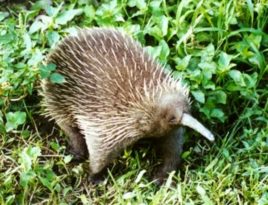- Series:Animals, Transcript English
Genesis 1:25
“And God made the beast of the earth after his kind, and cattle after their kind, and every thing that creepeth upon the earth after his kind: and God saw that it was good”.
 One of the most peculiar animals in Australia is the echidna – sometimes known popularly as the spiny anteater. There are actually four species of echidna, but they all resemble the anteater of the Americas. However, they have a number of unique features, the most famous of which is the fact that they lay eggs. For that reason, they are classed along with the platypus in the group monotremes. In fact, Wikipedia – that “fount of all knowledge” – suggests that they “evidently evolved between 20 and 50 million years ago, descending from a platypus-like monotreme”. Yet, their behavior is entirely different from the platypus. If the platypus and echidna were both species of bird, no evolutionist would suggest that one evolved from the other.
One of the most peculiar animals in Australia is the echidna – sometimes known popularly as the spiny anteater. There are actually four species of echidna, but they all resemble the anteater of the Americas. However, they have a number of unique features, the most famous of which is the fact that they lay eggs. For that reason, they are classed along with the platypus in the group monotremes. In fact, Wikipedia – that “fount of all knowledge” – suggests that they “evidently evolved between 20 and 50 million years ago, descending from a platypus-like monotreme”. Yet, their behavior is entirely different from the platypus. If the platypus and echidna were both species of bird, no evolutionist would suggest that one evolved from the other.
Platypuses lay a group of eggs in a burrow and then sit on them. Echidnas, in contrast, lay a single egg, which the female then places in a pouch. In this respect, they are showing a behavior similar to marsupials. We also don’t need to point out the obvious differences in appearance between the animals and their habitats. Are they really suggesting that the echidna just lost its beak over a period of time?
More to the point is the fact that the oldest known fossils of both platypuses and echidnas – old by evolutionary dating methods, that is to say – show no difference from the modern animals. It makes far more sense to say that these animals were designed by God. Author: Paul F. Taylor
Once again, we stand in awe of your awesome creation, Lord God. And in the midst of Your creation, we thank You that You consider us. Amen.
Ref: Doolan, R., The echidna enigma, Creation 18(2):26–27—March 1996. Image: CC BY-SA 3.0.
